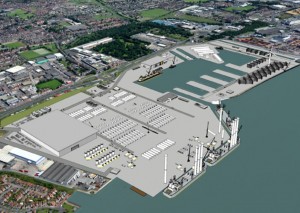Labour party set out its plans for housing and infrastructure

At its annual conference in Brighton, the Labour party has added detail to its plans to reinvigorate social house building, take more state control of infrastructure projects and offer employees additional rights.
Newly-appointed shadow housing minister John Healey launched a paper outlining Labour’s alternative proposals for increasing output in this Parliament, 2015-20. It believes that output from the social sector – although including units for sale – can be scaled up to reach up to 100,000 extra units a year by 2020.
The report proposes five measures:
- Giving councils the freedom to borrow against their assets, creating up to 60,000 additional homes over five years.
- Tightening the obligations of commercial developers to fund more new social homes through the planning system, restoring the number of homes delivered through this method to enable 16,000 new homes a year.
- Reform of Right to Buy to actually deliver one-for-one replacements, bringing in 6,000 additional replacement homes per year compared to the status quo.
- Using the power of the government balance sheet to bring down the cost of finance for housing associations by extending the guarantee scheme, creating an additional 2,000 homes per year.
- Funding a significant HCA grant programme to allow councils and housing associations to build at scale, and lever in private finance. Calculating the grant needed at £60,000 per unit, the same level offered in 2008-11, would enable an average of 30,000 additional units per year.
Healey’s report also proposes looking at ideas from France, “where the introduction of popular tax-free savings accounts now provides the source for a good deal of the country’s social housing finance”, and Denmark, “where there is a national mechanism for pooling and recycling housing association surpluses”.
The speech by John McDonnell, the new shadow chancellor, was billed as a “rejection of austerity politics”. He set out a plan to transform the Department for Business, Innovation and Skills, creating “a powerful economic development department, in charge of public investment, infrastructure planning and setting new standards at work for all employees”.
This would also involve creating “an effectively resourced and empowered national investment bank”.
McDonnell announced that Sir Bob Kerslake, formerly head of the civil service in 2012-14 under the coalition, chairman of the Peabody Trust and also a former chief executive of the Homes and Communities Agency, has been appointed to conduct a review of the Treasury as part of a wider look at the role of the state in economic life.
Meanwhile, Angela Eagle, shadow first secretary of state and shadow secretary of state for business, innovation and skills, described a “race to the top” driven by more R&D investment and innovation, and supported by government-backed industrial strategies.
She referred to a “skills emergency” in construction, manufacturing, science, engineering and technology.
The conference also passed a motion calling for a “new deal” for workers that would include a new Ministry of Labour, extending employment rights to the first day of employment, and a “genuine” Living Wage.
Brian Rye, acting general secretary of UCATT, who seconded the motion, said: “For the majority of private sector construction workers, employment tends to be nasty, brutish and short. Most workers do not have a permanent employer. Most large construction companies barely employ a single construction worker.”
This story is from construction-manager.co.uk













